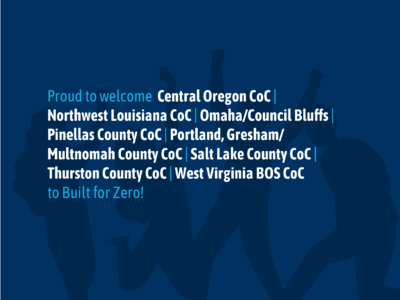For the Portland, Oregon and Gresham/Multnomah County Continuum of Care, joining Built for Zero was a step toward leveraging quality data and transparent funding in service of homelessness response. The region became a Built for Zero community in Fall 2021.
Beth Sandor, a Director of Built for Zero, recently joined in conversation with podcast hosts Alex Titus and Ben Bowman on The Bridge by OR360 to discuss homelessness response for the municipality.
Also present was Lori Kelly, a Planning and Evaluation Manager at the Joint Office of Homelessness Services in Portland.
Sandor has been working in the field of homelessness response since 1998. In those years, Sandor has confronted convoluted systems and learned to implement rigorous improvements to the effort of homelessness reduction.
Quality data is necessary to end homelessness
“How would we know a community had ended homelessness?” Sandor asked. “When we launched Built for Zero, what became clear is that there were these national intentions to end homelessness, but there weren’t measurable definitions of what that meant.”
Measurable definitions of homelessness are necessary to align shared aims for solving homelessness. Another key approach is collecting data on people entering, exiting, and transitioning from homelessness.
“If you are going to hold yourself accountable to a measurable outcome, the very first thing you have to do is have full line of sight into the dynamics of homelessness in your community,” Sandor said. She explained that this data reveals deep insights on where the “leverage points are to solve it.”
“You’re going to need to case conference, you’re going to need to connect people. You’re gonna need to analyze the data to see your gaps and services.”
Lori Kelly
In order to be effective, these quality datasets must also engage resources in service of resolving homelessness. Individuals also provide consent for their information to be stored, and can revoke consent at any time.
However, data alone is not enough to reduce homelessness. Systems change requires both the proper deployment of technology, combined with action-focused follow up.
“You’re going to need to case conference, you’re going to need to connect people. You’re gonna need to analyze the data to see your gaps and services,” said Lori Kelly. For Kelly, Built for Zero reflected a clear set of competencies that directed Portland’s approach to process improvement.
Improving homelessness response in large cities like Portland
Portland joins other cities in Built for Zero with large populations and complex systems to navigate toward an end to homelessness.
So far, 14 Built for Zero communities have proven that homelessness is solvable, by reaching functional zero for veteran or chronic homelessness. Functional zero means that communities have made homelessness equitably rare, brief, and nonrecurring. Another 42 communities have made measurable reductions in homelessness, including large cities such as Washington, D.C., Detroit, and Metro Denver.
“Places like Washington D.C., a very dense, very complex environment in a regional context with lots of other communities around it… are seeing really incredible outcomes,” Sandor said.
Another city seeing success in reducing homelessness is Metro Denver.
“Metro Denver, which is actually a multi-county multi-city jurisdiction that is trying to bring together many, many players to drive reductions,” Sandor said. “Over the last several years, they’ve seen sustained reductions in veteran homelessness when they’ve really focused on that population.”
Portland is part of the Built for Zero movement to end homelessness
Portland is one of seven Oregon communities that are part of Built for Zero. The city and its surrounding areas of Gresham and Multnomah County joined the initiative with the aim of reducing chronic homelessness.
They’re currently in the process of building out a by-name database of every unhoused person, with the conditions around their homelessness. Kelly explains that they’ll use this shared data to improve coordination across agencies.
“That’s really the big challenge here in Portland,” Kelly said. “Getting people to services and making sure that agencies are coordinating across each other can be complicated.”
But when agencies work together, they have the ability to house more people by streamlining their efforts and being more strategic about their resources.
“This is something we’re already doing, but we’re going to be doing in a more robust fashion, which means we’ll be reaching more people,” Kelly said.



